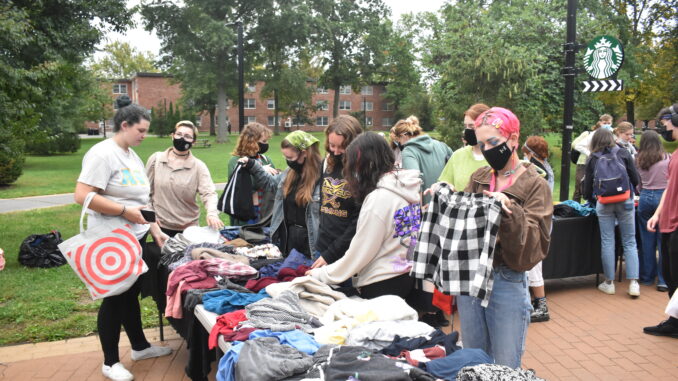
Clothing waste is a huge problem in America today. Corporations are pumping out clothing at a rate so fast that consumers are unable to keep up and the result is people buying more clothes than they are actually in need of.
To resist this, the Environmental Alliance, a student-run organization on the SUNY New Paltz campus, organized a clothing swap that took place on Parker Quad on Oct. 5. The goal of this event was to both educate students on being more clothing conscious and to do their part in keeping the unwanted clothes of people out of landfills and into the hands of those who want them.
“A huge part of waste in the world is fashion and textile waste, so keeping whatever clothing is already in circulation there is the thought behind the clothing swap,” says the secretary of the Environmental Alliance, Katie Gudzik when asked about the purpose of the event.
According to The United States Environmental Protection Agency (EPA), in 2018, 11.3 million tons of textile waste were sent to landfills in the United States. The volume of clothing and textile waste in America has been on an upward trend for a very long time.
Most of these problems with textiles in landfills are due to fast fashion where companies are producing frail clothing designed not to last. The short shelf life of the articles lead to a higher volume of textiles in landfills at an increasingly fast rate.
“[We should do] anything to slow fashion as much as we can,” adds third-year environmental geochemical science major and social media manager of the Environmental Alliance, Emma Paulsen.
Along with the fragility of these “fast” articles of clothing, they are also made from cheaper, unrecyclable materials, which mean that these pieces of clothing are destined to go to the landfill.
Blended materials like polyester and spandex are not able to be recycled and will undeniably be destined for life in the landfill. Not buying clothing made from these materials altogether is one way of preventing them from entering the landfill, but also reusing them and purchasing them secondhand will slow this process down.
“[Stray] away from any blended materials such as cotton-poly blends, or anything made of fossil fuels [such as] polyester, nylon, acrylic or spandex,” says Gudzik. “[These] cannot be recycled and we want clothing to be as renewable as possible.”
The Clothing Swap on Parker Quad gave students a way to make their clothing renewable, to exchange things they no longer want for things they do want and make them more clothing-conscious consumers.
“Wear what you have and love what you own,” Gudzik said. “When you do need to get new clothing, start in thrift stores or yard sales, second hand is always the best way to go.”
There are many options for staying sustainable in New Paltz. The Salvation Army at 61 N Chestnut St. is a great place to look for secondhand items and clothing, along with many other stores in and around town.
Aside from that, keeping an eye out for more events like the Clothing Swap is a great way to continue making New Paltz green. There were a lot of students present at the Clothing Swap, and due to the success of the event, the Environmental Alliance will be hosting another Clothing Swap in the Spring. Remember to check their Instagram @ecoallies_np.

